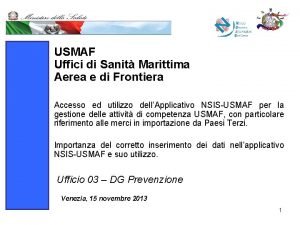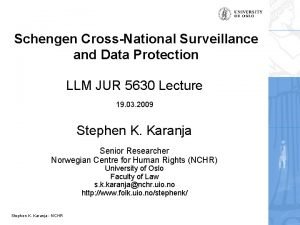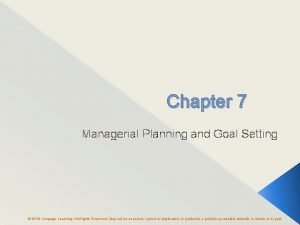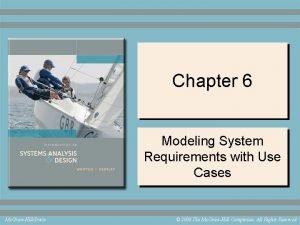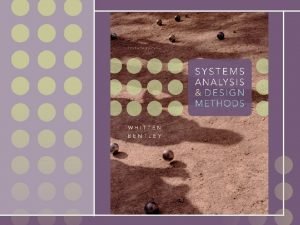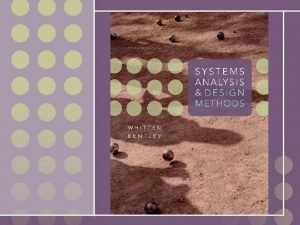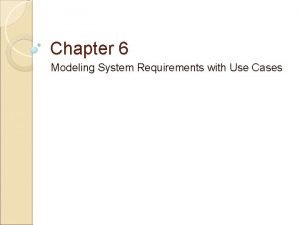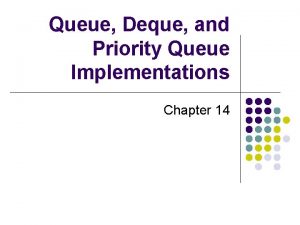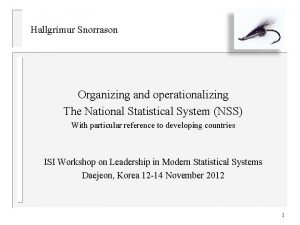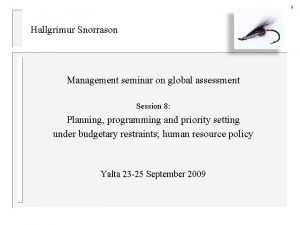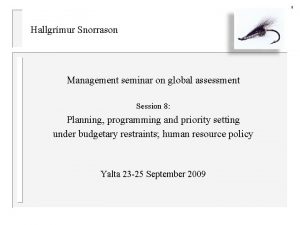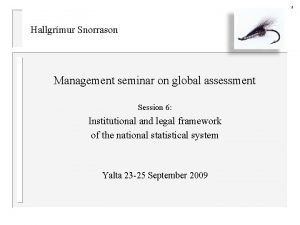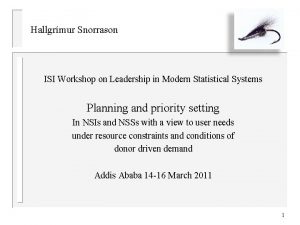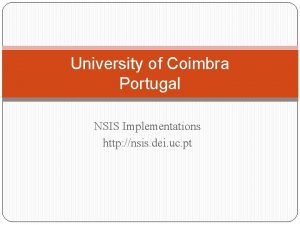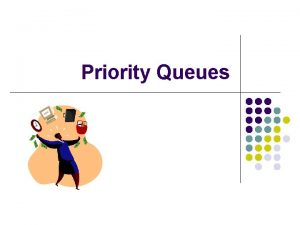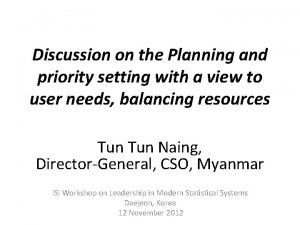Hallgrmur Snorrason Planning and priority setting In NSIs



















- Slides: 19

Hallgrímur Snorrason Planning and priority setting In NSIs and NSSs with particular reference to developing countries ISI Workshop on Leadership in Modern Statistical Systems Daejeon, Korea 12 -14 November 2012 1

Background: The Speaker n n n Hallgrímur Snorrason, born 1947, Icelandic Educated in Iceland, Scotland Sweden National Economic Institute, Iceland 1972 -1984 Director General of Statistics Iceland 1985 -2007 Active participant in international statistical cooperation – Nordic stat. coop. , EFTA, UNECE, UN Statistical Commission, European Union (European Statistical System), IAOS (President 1993 -1995), ISI Vice-President 2009 -2013 Consultant/lecturer on official statistics (e. g. Baltic, Balkan, African, and Arab countries, Ukraine, Greece; work for EFTA, Eurostat, World Bank, IMF, Nordic statistical institutes) 2

Managing demand – priority setting n Normal situation: NSIs and other NSS agencies face larger demands for statistics than they can cope with comfortably – – n Demand for statistics is characterized by: – – n n Internally from government, businesses, research institutions Externally from development partners (donors) and internat. institutions Large number of subject matters – hence need for surveys Large and costly sample surveys Demand for a high frequency of surveys Requests for a high level of detail and data on small areas Erratic demand from government for special services Demand from international organisations for special surveys 3

Need to prioritize! How to prioritize? n n n Need to meet the large demand by prioritizing – selecting which statistics shall be produced, their frequency and level of detail Prioritization has to be done in consultation with users, domestic and international Basic statistical requirements – such as national accounts – must not be neglected – but given high priority NSIs must also observe the balance in their statistical production – between different users (government, businesses, education and research) and between different types of statistics (economic, social, environment) NSIs have or should have the best overview to prioritize 4

Consultation and cooperation on priority setting n n n Establish dialogue with users (government, user groups, councils, development agencies) Explain and discuss scarce capacity and other limitations Seek cooperation in setting priorities Coordinate demand from national and international users (align national demand with international requirements) Ensure the use of international definitions, classifications and practices and abandon special domestic standards Seek cooperation with international agencies on demand priorities 5

Need for planning in general n Planning is needed in order to – – – n Ensure that we use our scarce resources efficiently Ensure that we follow our priorities and meet our most important demand in a systematic way Ensure the smooth running of the statistical production, the NSI and the NSS Planning is an important tool for internal coordination and cooperation – – For involvement of staff in the statistical activities For communications between the different levels and across departments, divisions and boundaries 6

Conditions under donor driven demand n n Special circumstances in developing countries with much presence and participation by development agencies (donors) Donors/development agencies have their own priorities, their own agendas for ensuring the generation of specific statistics, for their funding of activities, on surveys Donor demand donor programmes for obtaining information on specific issues, on monitoring developments are often not coordinated or not much coordinated Such demand, such donor agendas may compete with each other and be in conflict with the strategic plans of the NSI/NSS and their plans for implementation 7

Resource constraints n n n Donor agendas and their leverage through funding or co-funding of statistical projects make the need for planning and priority setting especially great The donor driven demand must be brought in line with or weighed against domestic requirements, targets and priorities The reasons are not only budgetary or funding constraints but also human resource constraints and crowding out of effects Human resources are scarce, capacities for collecting data, editing, processing and analysing are limited, often very limited Statistical activities (donor projects and national ones) will compete for the scarce human resources 8

Coping with competition for scarce resources n n Good and bad practices Some bad ones: – – – n No clear national agenda, hence donors do what they like There is a national agenda but donor activities are outside of it Donor projects are carried out by external expertise, external HR, wholly or partly – hence little/no learning effect, no sustainability Some good ones: – – – Donor/development agencies are involved in and contribute to the planning of the statistical programmes National agendas and donor agendas are aligned, coordinated Statistical activities are undertaken with maximum involvement of national experts – to maximize learning and sustainability 9

Short-term and medium term planning n Short-term – annual plans for implementation, preparations, timing and conduct of activities. These are important for – – – n Organizing the internal work of the NSI/NSS agency Making effective use of the scarce resources of the agency Planning the work within the different divisions of the agencies Medium term – multi-year plans for the overall statistical programme. These shall show – – – The regular and basic production (data collection/surveys, processing etc. ) of the NSI The cycle of major surveys (censuses, IHSs, DHSs, MICS, WMSs) The scope for and main ideas for ad-hoc surveys 10

Importance of medium term/multi-year plans n The medium term plans are particularly important for – – – n Setting the stage for the activities of donor funded activities Obtaining agreement on the frequency and timing of surveys Making sure that the learning aspect is observed so as to increase the chances for sustainability Planning the degree of involvement of national v. international experts Avoiding harmful interuptions of unplanned ad-hoc surveys Experience (TFSCB evaluation 2010) has shown that donors/development partners welcome the drawing up and existence of multi-year plans 11

Different planning processes – multi-year plan n Multi-year planning – involves – – – n Multi-year planning – requires – – n Deciding on priorities for the next few years Setting out the main targets, main activities in broad terms Establishing an implementation plan Consultations with government Consultations among the partners in the NSS Consultations with national users Involvement by development agencies The multi-year plan should be considered a living document to be revisited annually and adjusted for changes in priorities 12

Different planning processes – annual plan n n The annual programme of work should be based on the multiyear plan The multi-year plan is outward looking – the annual programme of work is more inward looking setting out how and when the actions of the multi-year plan are to carried out each year The annual programme outlines the co-existence of the regular/continuous activities, the large survey(s) to be carried out during the year and possible ad-hoc surveys It sets out the resource requirements for the specific activities or surveys It has clear targets for timing of data collection, processing and release of findings 13

Annual planning process – common complaints n n All NSIs have some kind of planning mechanism The process of planning and coordination is often found or perceived to be inadequate –common complaints are e. g. – Lack of participation in the planning process – Lack of coordination in the planning – Inadequate flow of information within individual units – Inadequate communication across boundaries (between units, between departments) – lack of coordination between units – Little coordination in decision making – Bad distribution of financial and human resources 14

Preparing the annual work programme n n n The planning process may depend on the size of the NSI but irrespective of size it is important to involve professional staff in one way or another Main priorities are derived from the multi-year programme and set a top level but the planning of how to reach them should be based on a bottom-up approach/substantial involvement of the units Important planning activities: – – Consultations within units resulting in proposals/inputs to division directors Specifications of actions with quantification of resource requirements: time, human resources (quantity, kind), claims on IT, demand on effort from other departments 15

Preparing the annual work programme cont. – – – The planning inputs should be submitted by division directors (heads of departments) to the DG and central management The different programme elements should be discussed by central management with feedback to/consultations with dept. heads After discussion the annual programme of work should be adopted by the DG and central management The programme of work should be presented to the staff (meetings, presentation on the internal website etc. The programme should be published on the website of the NSI The work programme should be monitored and reported on on the website (e. g. quarterly, twice a year) 16

Staff involvement n Staff involvement in planning is important – – n Staff involvement should be mobilized – – n n For helping to ensure that we follow our plans and priorities and reach the objective for the statistical production at the required level of quality To motivate staff and support job satisfaction For regular follow-up of the activity plans By regular meetings of all relevant staff in each unit and meetings between division/department director and heads of units Need for applying project management across boundaries Central management must be responsive – By regular meetings (weekly, bi-weekly) with formal agenda based on proposals from division directors, formal decisions on actions and on follow-up, formal reporting to staff (also involving regional offices) 17

Some discussion points - suggestions n n n Practices or experience with user consultations How to establish priorities: by the NSI, by the NSS, through consultations with government, other user consultations? Practices or experience under donor driven demand – donor coordination The role of multi-year planning, of strategic plans (NSDSs), implementation plans How much weight should we give to the annual programme of work, how much time should we spend on it, to what extent should we involve staff in preparing it? 18

Hallgrímur Snorrason Thank you for your attention 19
 Nsis sanita
Nsis sanita Nsis schengen
Nsis schengen Burman's priority list gives priority to
Burman's priority list gives priority to Priority mail vs priority mail express
Priority mail vs priority mail express Characteristics of goal setting
Characteristics of goal setting Chapter 8 planning and goal-setting
Chapter 8 planning and goal-setting Goal setting and action planning chart example
Goal setting and action planning chart example Understanding jim crow (setting the setting)
Understanding jim crow (setting the setting) Proactive planning and reactive planning
Proactive planning and reactive planning Long medium and short term planning in primary schools
Long medium and short term planning in primary schools Language planning and policy slideshare
Language planning and policy slideshare Use case ranking and priority matrix images
Use case ranking and priority matrix images Use case priority matrix for system
Use case priority matrix for system Use case ranking and priority matrix
Use case ranking and priority matrix Use case model
Use case model Deque and priority queue
Deque and priority queue Use case ranking and priority matrix images
Use case ranking and priority matrix images Member2club
Member2club Strategic planning vs tactical planning
Strategic planning vs tactical planning Planning balance sheet in urban planning
Planning balance sheet in urban planning
